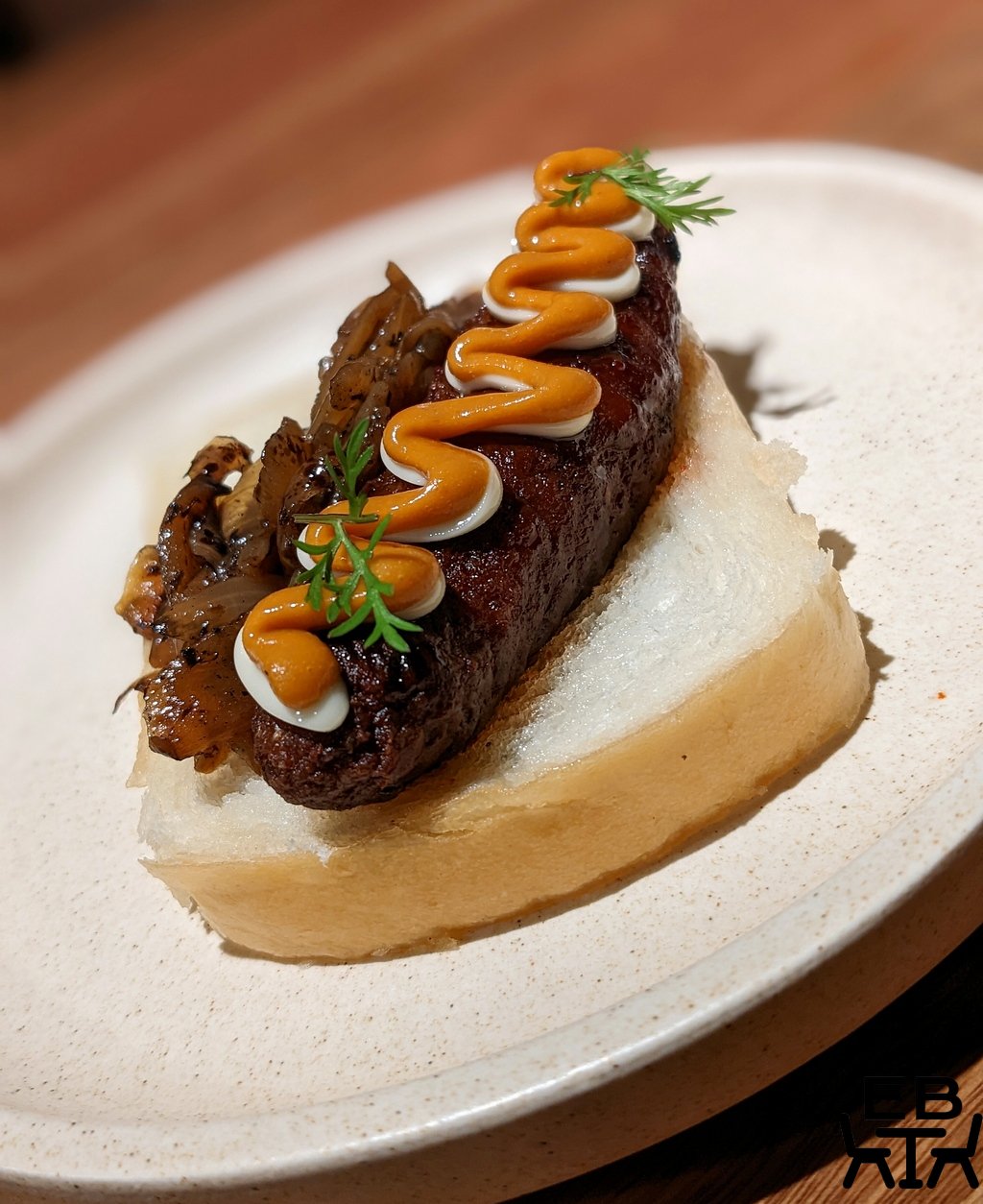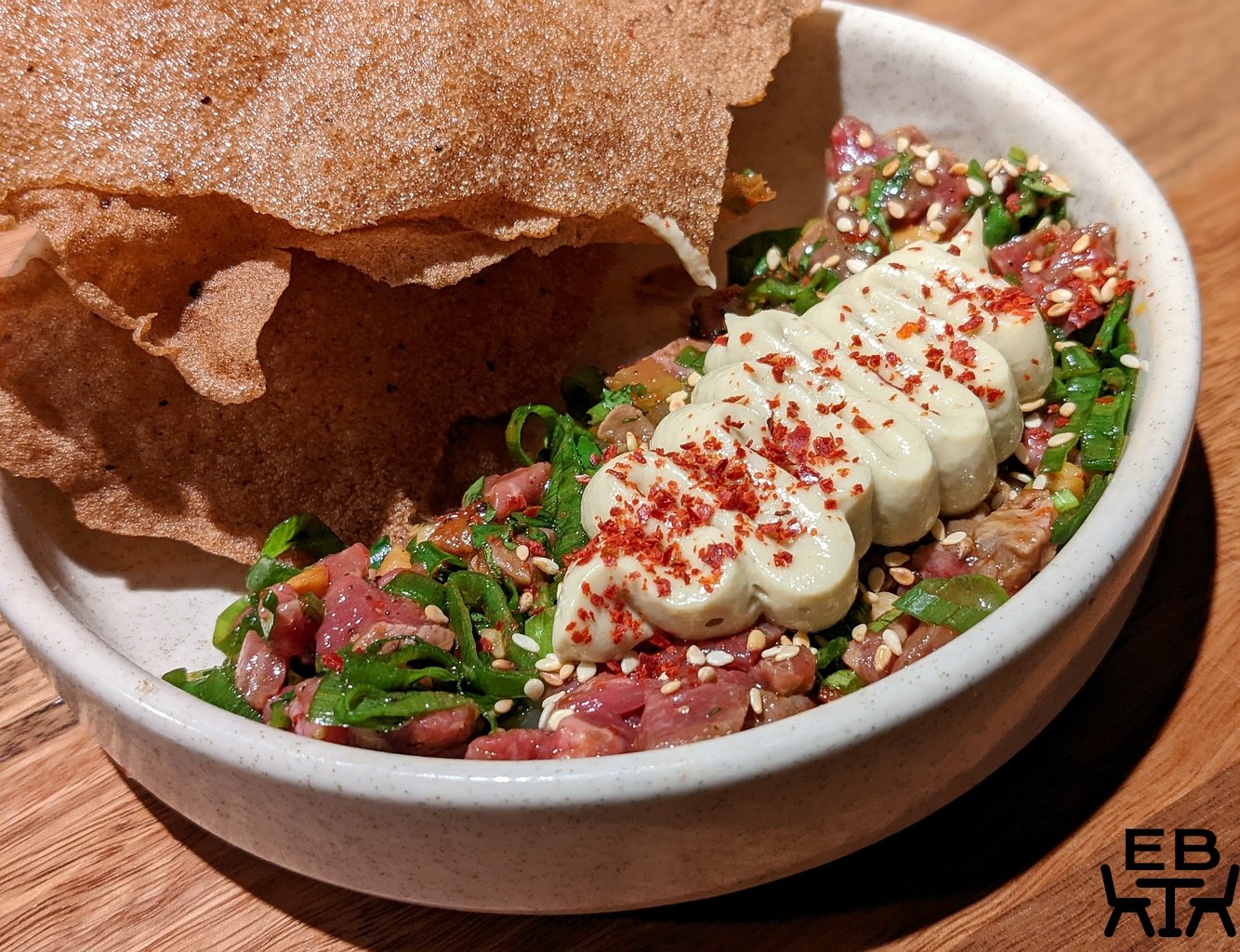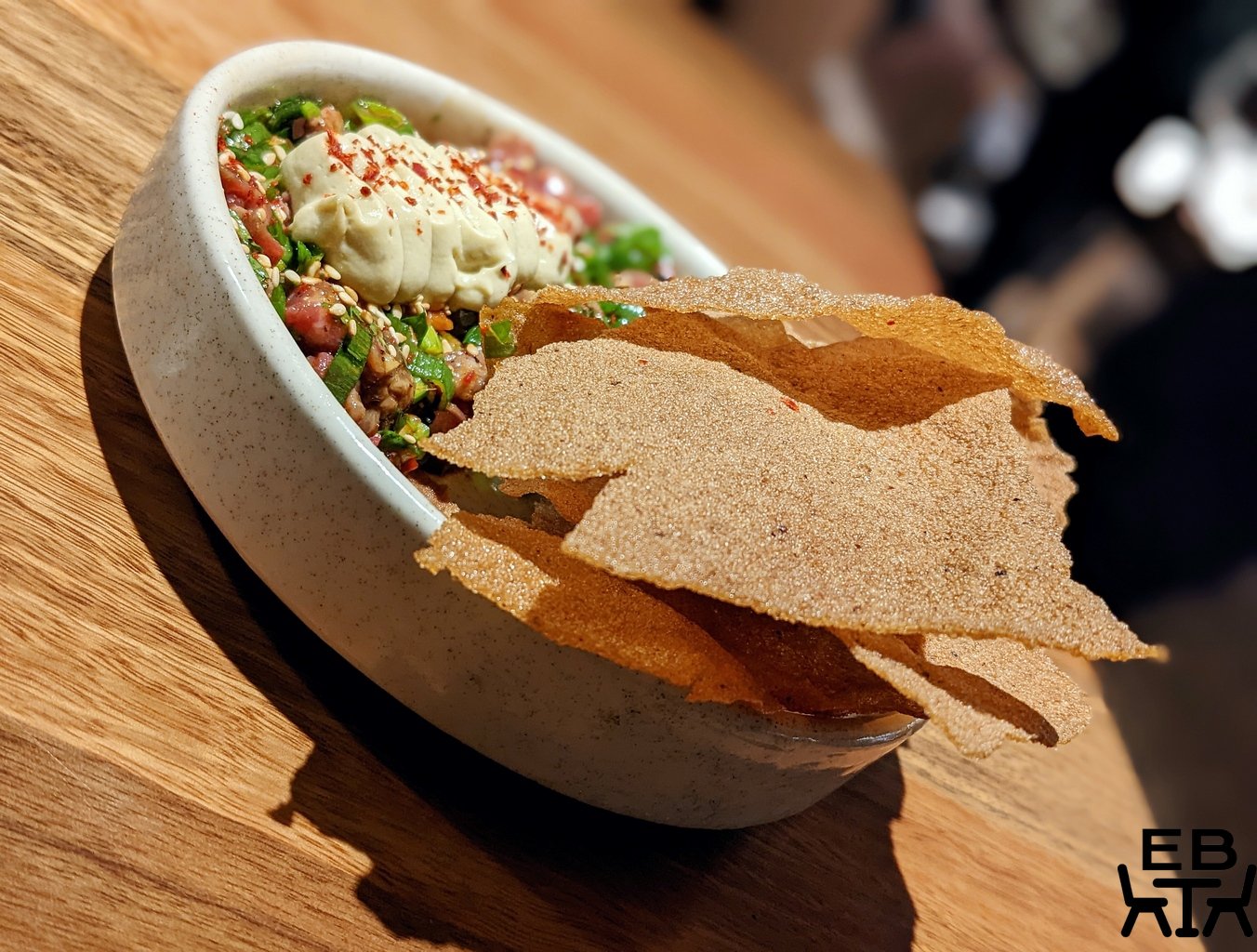Aru is a next venture from the same chef who opened Sunda, which is known for Southeast Asian meets Native Australian flavours. Aru was said to have similar fusion flavours but perhaps different techniques. A friend kindly gifted us a voucher to visit, which added even more impetus.
Aru is tucked away in Little Collins Lane in the CBD. As with many other cool Melbourne eateries, the entrance was subtle and not at all obvious. Trying to figure out where it actually was from where it looked like it was on Google Maps took some wandering up and down the street. If you too are stuck looking for it, our tip is this – there is no signage on the outside, it’s on the inside, through the glass doors. I guess you’re just supposed to know..

Once through the door, the open kitchen running alongside most of the dining area immediately draws your attention. The eatery is a long space, and evidently the kitchen at work is meant to be on display.
We had made a reservation, and staff showed us to a table near the kitchen pass. It would have been interesting to keep watching, but we asked to be moved to a different table after not long, because the speakers were right near that as well, and the music had a driving bass that made it difficult to hear conversation at your own table.

Aru has a substantial drinks menu – a thick binder that far outweighs the food menu, which was just on one side of an A4 sheet. The food menu was divided into sections of Bite and snacks, Small plates, Large plates, and Vegetable sides. As is quite typical these days, the dishes were listed as key components, with no additional details like clues on cooking techniques.

We chose a number of dishes that looked interesting to share – including some of the Bites, which although are meant to be one person serves per order, we opted for the single serves of to try a greater variety instead.
Smoked scallop, turmeric mayo, tamarind jam, toasted baguette. The scallops were a good size, and tender. There was a slight char flavour both from the scallops and the toast. The turmeric mayo and tamarind jam delivered a good mix of sweetness, curry notes, herby freshness, and a finishing chilli fire.



Duck sausage sanga, leatherwood honey, onion, peanut hoisin. This was one of their better-known dishes, and so one we had to try. This was a representation of their fusion creativity, taking the quintessential sausage sizzle and making it fancy and adding not so typical flavours. It was presented in a more elevated way than you might get at your usual barbecue, with the sausage placed diagonally across the almost luminously white bread, mayo and sauce neatly squiggled atop it, and caramelised onions nestled beside it.


The duck sausage, despite its somewhat gnarled appearance, was actually quite soft. It had no casing to detract from the texture, and there was no stringiness or gristle to it. The distinctive taste of leatherwood honey was present right at the end. It was explained that the bread was bao bread, so made from a different dough than usual bread. It was light and fluffy, and again just that extra twist on the usual sandwich bread. You could see the work that had gone in to making this something not quite ordinary.

Pate en croute, flavours of banh mi. This was another dish they were known for. Pate en croute is a French dish, essentially a terrine wrapped in a crust. Served as a cross-section slice, you could see the different meats, like a stained glass patchwork. It had compacted meats of the kind you would find in your usual banh mi. The shredded carrots and radish were done with a familiar pickle – again, what you would get in banh mi. There was a variety of texture from the different cuts of meat and slivers of black fungus. There were also slices of chilli scattered through it, but with the heat taken out. To complete the flavour profile, there was a jellied hoisin and soy sauce layer at the top of the slice. A thin, burnished layer of pastry encased it all. It was a clever rendition of banh mi, and delivered the components and flavours in a novel format. Considering the significant French influence on Vietnamese cuisine, this would almost be a natural progression for the dish – although much less portable than banh mi. And we did miss the flaky crispness of a baguette.



Raw beef, smoked oyster, salted chilli, macadamia, sourdough. This beef tartare was more prettily plated than most. The meat was pressed along one side of the dish, topped with bright colours from sliced greens, and ripples of the smoked mussel cream. Air-puffed crisps were arranged on the other side of the dish like layered sails. We were told to mix the tartare components together. The beef was diced into small pieces, and was coated by the smoked oyster cream well – a good ratio of surface area to volume. It definitely had smoky flavour. The diced spring onions and coriander provided some freshness to balance it out. The sourdough crackers had a lightly brittle crispness to them, and were a little savoury in themselves. All together, it was a tasty combination.



Kingfish collar, dry native curry, orange kosho, lime. This was simply presented, in contrast to some of the earlier dishes. The burnished cut of fish was centrestage on the plate, accompanied by a dollop of the kosho and a charred lime half. Despite the pared back presentation, the fish was perfectly cooked. It had soft flesh, and was well-seasoned. The orange kosho was punchy – mostly salty with a hint of sweetness. It wasn’t really needed though, as the kingfish carried enough flavour by itself.



Roasted chicken, ginger, sourdough bread miso, confit garlic. The roasted chicken pieces were nicely cooked, so they weren’t dry. The miso sourdough sauce was thick and rich, with an interesting deeper flavour, with a hint of sweetness. This was really the component that lifted the dish, which would otherwise have just been a pretty ordinary cooked chicken.



Spanner crab fried rice, white kampot pepper, sweet corn. The fried rice was served mostly shrouded with a topping of shredded crabmeat, kernels of sweet corn, and clumps of tobiko. The rice grains held together loosely, rather than being gluggy. It had a peppery heat to it, and pops of crunch and sweetness from the corn. Of the dishes we had though, this was the one we enjoyed the least. Despite the spanner crab in it, it seemed like a normal fried rice.



All in all, Aru felt a little hit and miss. There were highs of interesting flavours and combinations, but also some dishes that didn’t quite live up to what we hoped. The dishes we really liked? The smoked scallops, the pate en croute, and the beef tartare. Some of the others really didn’t make the enjoyment to price ratio. Although they were probably going for a buzzy environment, the sound levels were loud if you were trying to have an actual conversation. It was an alright dining experience, but not spectacular. Worth trying, but for the right dishes.

Scores:
Food: 3/4
Setting: 1/2
Service: 1/2
Total: 5/8
Price point: Single serves of the Bites $8 to $24, Small plates $25 to $34, Large plates $38 to $68. Fried rice $45.
Value: Variable, depending on the dish.
Details:
Address: 268 Little Collins St, Melbourne CBD
Phone: 03 9939 8113
Website: Aru







